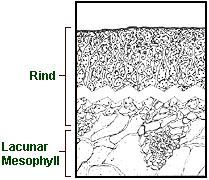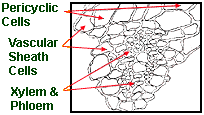Aloe Vera Leaf Handling And
|

|
|
| A composite photomicrographic section through the outer layers of the leaf of Aloe barbadensis Miller, showing the thick green rind and the outer portion of the lacunar mesophyll (mucilage). | |
Where are the Aloe Vera Constituents Made?
In figure 1, is a photomicrographic section through the outer portion of an Aloe leaf. The rind consists of 15-18 layers of cells interspersed with chloroplasts (small round bodies), where the constituents are synthesized, and with inclusions containing calcium oxalate and magnesium lactate crystals.Just beneath the thick green rind are located the vascular bundles. As shown in Figure 2, the outer support of the vascular bundle is provided by the sheath cells. Inside the vascular bundles are three types of tubular structures: the xylem (transports water and minerals from roots to leaf) the phloem (transports starches and other synthesized materials to the roots), and the large pericyclic tubules (containing the yellow latex or sap which is very high in the laxative anthraquinones, especially aloin).

|
|
| The various portions of the tubules of a vascular bundle are labeled. The pericyclic tubules contain the laxative agents of the yellow sap or latex. Xylem and phloem vessels serve in water and nutrient transport, respectively. | |
The anthraquinones absorb ultra violet rays of the sun and prevent overheating of the central portion of the Aloe leaf, the water storage organ. Note that the pericyclic portion of the vascular bundle is adherent to the rind, while the remainder of the vascular bundle protrudes into the lacunar (large spaces) parenchyma or mesophyll, which is very thick and slimy. This provides a movable layer between the more solid inner gel fillet and the stiff outer rind. This liquid layer is termed the mucilage.
The innermost and major portion of the leaf is the spongy parenchyma or mesophyll constituting the gel filet. This layer has more structural integrity than the slimy mucilage layer.
All of the carbohydrate (polysaccharides) and glycoprotein (enzymes) constituents of the Aloe leaf are made in the thick green find. Carbohydrates synthesized in excess of that needed for energy metabolism are transported to the gel fillet for storage of water and minerals and carbohydrates.
The carbohydrates are transported by the phloem vessels to small cellulose-containing vessels in the gel fillet, which constitutes most of the pulp of the fillet. Water is then osmotically attracted to the carbohydrates serving as the water storage organ of the plant.
Aloe Vera Processing Methods - Video
The carbohydrates (and small amounts of lipids or fats) consist of carbon, oxygen and hydrogen. These are derived from carbon dioxide from the air taken into the leaf through the stomata (pores) at night, and water from the ground. There is no sunlight to energize the photosynthesis mechanism to change the CO2 into carbohydrate. The entrapped CO2 is stored as malic acid, which gives the internal part of the leaf an acidic pH of about 4.0. When sunlight hits the leaf, some of the malic acid can be changed to the carbohydrate used as fuel by the plant’s synthetic machinery. Only a portion of the carbohydrate is used for energy, the remainder being stored in the mucilage and gel fillet.
Aloe Vera Leaf Handling And Constituent Variability
Whole Leaf Aloe Vera - Home Whole Leaf Aloe Vera Products Aloe Vera Information